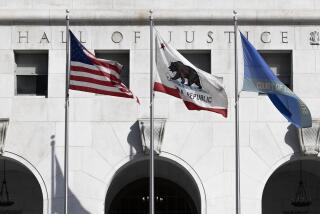High Court Is Urged to Revise Jury Selection
- Share via
The state Supreme Court was urged Tuesday to order changes in the Los Angeles County jury system to make it more likely that prospective jurors in criminal cases reflect the racial composition of the county as a whole.
“A black defendant, if tried in Santa Monica by a jury representative of just that community, will get a 90% white jury--even though the county is less than 50% white,” state Deputy Public Defender Donald L. A. Kerson told the justices.
It is “quite incredible,” Kerson said, to say that under the current system such a defendant could receive a “trial by his peers” when the jury reflected the makeup of a largely white community.
County Deputy Dist. Atty. George M. Palmer defended the process and asked the justices to strike down a state appeal court ruling that could force substantial revision of the way jurors are assigned in the county. “The system is constitutional,” he said.
Los Angeles Hearing
The justices heard arguments in Los Angeles in a case that could affect not only this county but other heavily populated areas in California as they select and assign prospective jurors. In Tuesday’s hourlong hearing, questions from the justices indicated that they may have difficulty balancing a defendant’s right to a representative jury with the practical problems of assigning jurors within a sprawling county of over 4,000 square miles.
Under judicial mandates, criminal defendants are entitled to trial by an impartial jury drawn from a representative cross-section of the community. While the trial jury itself need not reflect the community, the pool of prospective jurors from which it was chosen should approximate the community, the courts have held.
In Los Angeles County, prospective jurors are chosen at random from the county as a whole and assigned to duty in one of the county’s 11 judicial districts. But under a state law, enacted to minimize travel time, jurors may decline to serve at a courthouse further than 20 miles from their homes. To further reduce hardship, the county as a matter of policy tries to assign jurors to the courthouse nearest their residences.
In the case before the court, Edward C. Williams, a black defendant charged with first-degree murder in the slaying of a white businessman in 1980, challenged the constitutionality of the system used to provide jurors in the judicial district in Santa Monica where he faced trial.
Williams presented data showing that while 11.4% of the county population was black, only 4.5% of the prospective jurors then appearing for duty in Santa Monica Superior Court were black. He argued that he was thus being deprived of a right to trial by a jury reflecting the countywide community. He demanded that a new jury pool be created or that a mistrial be declared.
Court of Appeal Ruling
Last July, a state Court of Appeal in Los Angeles held that while jury pools need not mirror the countywide population, they should go beyond the relatively narrow boundaries of a judicial district to reflect the broader, 20-mile radius of the courthouse that serves as an effective limit for juror assignment under state law. The appeal court said that because the 20-mile radius covers more area, it would provide “potential to be more diverse” than smaller judicial districts, and should serve as the “community” that juror pools should reflect.
County authorities appealed the ruling to the state Supreme Court, saying that using a 20-mile radius from the county’s numerous courthouses to define a “community” would prove unworkable. Inevitably, officials said, such jury pools would overlap, causing some jurors to be called more than others and increasing travel time for many who otherwise would be going to the courthouse nearest their homes.
More to Read
Sign up for Essential California
The most important California stories and recommendations in your inbox every morning.
You may occasionally receive promotional content from the Los Angeles Times.










